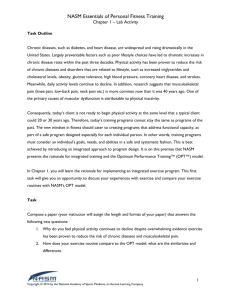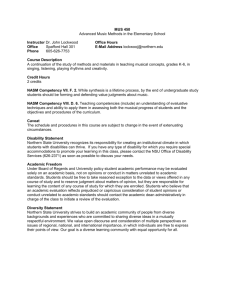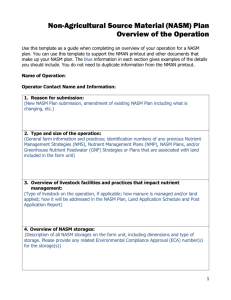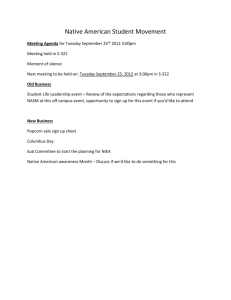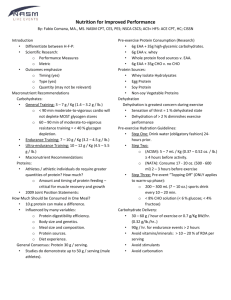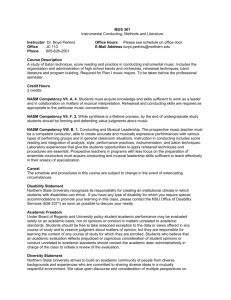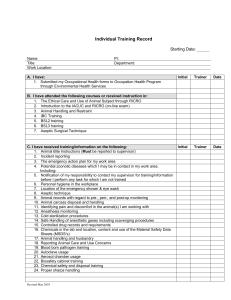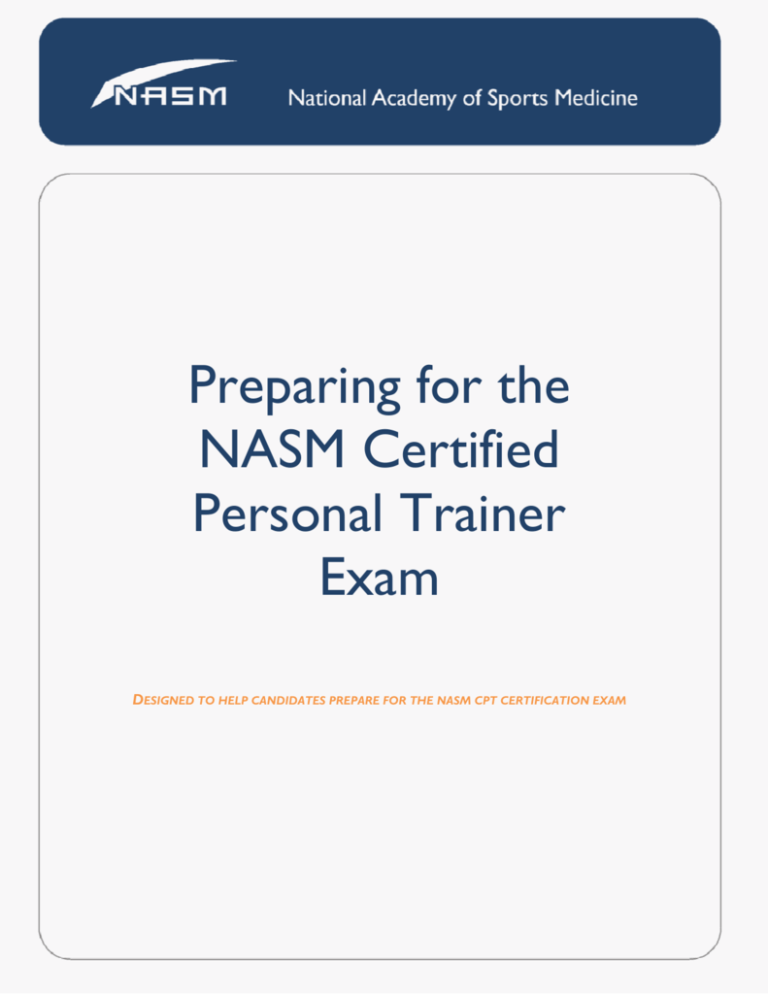
Preparing for the
NASM Certified
Personal Trainer
Exam
DESIGNED TO HELP CANDIDATES PREPARE FOR THE NASM CPT CERTIFICATION EXAM
Preparing for the NASM Certified Personal Trainer Exam
Copyright © 2011 National Academy of Sports Medicine
Printed in the United States of America
All rights reserved. Except for use in a review, the reproduction or utilization of this work in any
form or any electronic, mechanical or other means, now known or hereafter invented, including
xerography, photocopying and recording, and in any information-retrieval system is forbidden
without the written permission of the National Academy of Sports Medicine.
Distributed by:
National Academy of Sports Medicine
5845 E. Still Cr. Suite #206
Mesa, AZ 85206
800.460.NASM
Facsimile: 480.656.3276
http: //www.nasm.org
Author:
Brian Sutton MS, MA, PES, CES, NASM-CPT
2
Preparing for the NASM Certified Personal Trainer Exam
Table of Contents
Introduction
4.
Utilizing the NASM Essentials of Personal Fitness Training Materials
5.
Exam Breakdown
6.
Assessment
7.
Exercise Technique
9.
Flexibility
10.
Cardiorespiratory Training
11.
Core Training
12.
Balance Training
13.
Reactive Training
14.
Speed, Agility & Quickness Training
15.
Resistance Training
16.
Program Design
Special Populations
17.
18.
Nutrition
19.
Client Relations & Administration
20.
Professional Development & Responsibility
21.
3
Preparing for the NASM Certified Personal Trainer Exam
INTRODUCTION:
Welcome to the National Academy of Sports Medicine’s Essentials of Personal Fitness Training
home-study course. At NASM, our mission is to revolutionize the health and fitness industry by
providing education, solutions, and tools that produce remarkable results. We aim to give Health
and Fitness Professionals an integrated approach to health, allowing them to guide others toward
healthier lifestyles. Our educational continuum employs an easy-to-use, systematic approach in
order to apply scientific and clinically accepted concepts.
Getting Help:
At NASM, your success is our success. We want to help you in every way we can. The NASM
staff is available to offer any assistance you may need throughout the course of your program.
Whether you have technical or educational questions, we are available by phone and email 8:00
A.M
to 5:00 P.M (PST) Monday through Friday. Please call our toll free number at 1-800-460-6276 or
email us questions at www.nasm.org.
Study Tips:
The most important characteristic for students to possess is a deep and passionate desire to
learn. That said, the following tips should help you maximize the time spent on the course
materials. ***This is not an exhaustive list.
Note:
Although use of the Essentials of Personal Fitness Training Textbook and home-study course materials is
not a requirement for certification exam eligibility, the purpose of this manual is to maximize your learning
experience if you are utilizing those reference materials to prepare for the exam. Utilization of the
information in this manual does not guarantee an individual to pass the NASM-CPT exam.
4
Preparing for the NASM Certified Personal Trainer Exam
UTILIZING THE NASM ESSENTIALS OF PERSONAL FITNESS TRAINING
MATERIALS
1. Use all the tools- Textbook, Videos, Study Guide. Hint- The 45 day planner located in
the Study Guide will help keep you on track.
a. Step 1: Read a chapter in the text.
b. Step 2: Watch the corresponding video presentations for that chapter.
c. Step 3: Quiz yourself by filling out the Study Guide for that chapter.
d. Step 4: Review any topics from that chapter you find difficult.
2. Practice exam. Once you’ve completed all 18 chapters, take the online practice exam.
a. Take the online practice exam strictly from memory (close your book).
b. Mimic the exam conditions as best as you can. For example, take the practice at a
scheduled date and time and from another location (such as the library).
c. Also, don’t bother memorizing the specific questions on the practice exam (they
won’t be on the test) - instead get to know the “concepts”. If the practice exam
asks about X then maybe the final will ask about Y.
d. If you need help accessing the online practice exam please call 1-800-460-6276.
3. Attend a live workshop. The workshop is a great place to meet other trainers (maybe
form a study group), ask questions, and gain hands-on experience.
4. Call NASM (800-460-6276) with any questions. We are here to help you succeed!
5. Ask a friend/relative/mentor to quiz you. This is a great chance to test your
knowledge and show others how much you’ve learned.
6. Take your time at the testing center and read each question thoroughly.
7. Highlight important sentences in the text as you read and make notes on the side of the
page. Once you’re finished with the book, re-read your notes and highlights.
8. Study away from distractions.
9. Practice- Take what you learn and apply it in the gym with your own workouts.
10. Understanding vocabulary is essential to understanding the questions on the final. If
you don’t know what the question is asking, it’s hard to choose the right answer.
Highlight key vocabulary terms as you read the text and try to use them in a sentence.
5
Preparing for the NASM Certified Personal Trainer Exam
EXAM BREAKDOWN
Performance Domain
# Questions
Assessment
25
Exercise Technique
25
Program Design
25
Nutrition
10
Client Relations & Administration
10
Professional Development & Responsibility
5
Research Questions *
20
Total Exam Questions
120
*Research questions are questions undergoing analysis to determine if they can be used for future exams.
Research questions do not count against the candidates score. The candidate will not be advised as to
which questions are research questions. Research questions are an important part of developing fair and
statistically valid examinations.
Details of NASM-CPT Examination
Time given to complete exam
Two Hours
Score required to pass exam
70 scaled score
Format of exam questions
Multiple choice
Location of exam
Lasergrade testing facilities
Eligibility Requirements
18 Years of Age
NASM exam enrollment paid in full
Current CPR and AED certification
6
Preparing for the NASM Certified Personal Trainer Exam
EXAM BREAKDOWN - ASSESSMENT:
Certified Personal Trainers must realize that an effective training program begins with the
identification of the client’s training history, PAR-Q, medical history, goals, current and past
medications, physiological statistics (body composition, heart rate, anthropometric
measurements), posture, and the observation of movement dysfunctions. This domain includes:
Fundamentals of Human Movement Science (Chapters 1-4)
Nervous System, Skeletal System, Muscular System, Cardiorespiratory System
Biomechanics
Exercise Physiology
Fitness Assessment : Subjective Information (Chapter 5)
General and Medical History:
Occupation, Lifestyle, Medical, and Personal Information
Fitness Assessment: Objective Information (Chapter 5)
Physiological Assessments:
Heart Rate, Pulse, Blood Pressure
Body Composition Testing:
Body Fat Measurements, Circumference Measurements, Waist to Hip Ratio, BMI
Cardiorespiratory Assessments:
Step Test, Rockport Walk Test
Static and Dynamic Postural Assessments:
Overhead Squat, Single-Leg Squat, Pushing/Pulling Assessment
Performance Assessments:
Davies Test, Shark Skill Test, Bench Press Strength, Squat Strength
7
Preparing for the NASM Certified Personal Trainer Exam
Important Tables/Figures:
Table 2.3 (pg 34) Muscle Fiber Types
Table 2.4 (pg 35) Muscles as Movers
Table 3.1 (pg 43) Functions of the Heart
Table 3.5 (page 52) The Bioenergetic Continuum
Table 4.1 (pg 61) Examples of Planes, Motions, and Axes
Table 4.2 (pg 68) Muscle Action Spectrum
Table 5.2 (pg 107) Common Medication by Classification
Table 5.3 (pg 108) Effects of Medication of Heart Rate and Blood Pressure
Figure 5.25 (pg 123) Overhead Squat Checklist
Table 6.6 (pg 169) **very important Compensations, Muscle Imbalances, and Corrective
Strategies
Key Points:
Evidence of Muscular Dysfunction and Increased Injury (chapter 1, pg 5)
Integrated Training and the OPTTM Model (chapter 1, pg 7)
Anatomy of the Nervous System (chapter 2, pg 17)
Overview of the Skeletal System (chapter 2, pg 21)
Overview of the Muscular System (chapter 2, pg 29)
The Cardiovascular System (chapter 3, pg 40)
The Respiratory System (chapter 3, pg 46)
The Bioenergetic Continuum (chapter 3, pg 51 & 52)
Anatomic Locations (chapter 4, pg 59)
Planes of Motion, Axes, and Joint Motions (chapter 4, pg 60)
Muscle Actions (chapter 4, pg 62)
Motor Behavior (chapter 4, pg 91)
PAR-Q = Physical Activity Readiness Questionnaire (chapter 5, pg 102)
Subjective Assessments (chapter 5, pg 102)
Objective Assessments (chapter 5, pg 108)
8
Preparing for the NASM Certified Personal Trainer Exam
EXAM BREAKDOWN - EXERCISE TECHNIQUE:
Proper application and execution of the chosen exercise(s) is one of the most critical success
factors for clients to reach their goal and reduce the risk of injury while training and performing
activities of daily living. The Certified Personal Trainer plays an important role not only as a
facilitator of exercise, but as an educator of health and fitness.
You need to know how to:
1. Categorize every exercise
2. Regress every exercise
3. Progress every exercise
4. Perform every exercise
Example: A “single-leg balance reach” is what type of exercise?
A. Balance Stabilization
B. Balance Strength
C. Core Stabilization
D. Reactive Stabilization
Example: What is the appropriate regression of the “Prone Iso-Ab”
A. Prone Iso-Ab with hands on a bench
B. Prone Iso-Ab with Hip Abduction
C. Side-lying Iso-Ab
D. Short-lever floor crunch
Example: Which chest exercise is appropriate for a client training in Phase 1 of the OPT Model?
A. Bench Press
B. Medicine Ball Chest Pass
C. Stability Ball DB Chest Press
D. Speed Bench Press
9
Preparing for the NASM Certified Personal Trainer Exam
Flexibility Training Concepts (Chapter 6)
Flexibility
Continuum
Corrective
Flexibility
Active Flexibility
Functional
Flexibility
SMR & Static
(Phase 1)
SMR & Active
Isolated
(Phases 2,3,4)
SMR & Dynamic
(Phase 5)
Important Concepts/Definitions:
Relative Flexibility (pg 142)
Muscle Imbalance (pg 142)
Synergistic Dominance (pg 144)
Altered Reciprocal Inhibition (144)
Autogenic Inhibition (pg 146)
Anatomy & Physiology:
Muscle Spindle (pg 145)
Golgi Tendon Organs (pg 146)
Cumulative Injury Cycle (147)
Davis’s Law (pg 148)
Acute Variables:
Self-Myofascial Release (SMR): Hold tender area for 20-30 seconds
Static Stretch: Hold stretch for 20-30 seconds
Active-Isolated Stretching: Hold stretch for 1-2 seconds for 5-10 repetitions
Dynamic Stretching: 10-15 repetitions, 3-10 exercises
Study the pictures of the stretches in the textbook.
10
Preparing for the NASM Certified Personal Trainer Exam
Cardiorespiratory Training Concepts (Chapter 7)
Cardio Training
Zone 1
65-75% Max Heart
Rate
Zone 2
80-85% Max Heart
Rate
Zone 3
86-90% Max Heart
Rate
Phase 1
Phases 2, 3, 4
Phase 5
Important Terms:
General & Specific Warm-up (pg 174)
EPOC: Excess Postexercise Oxygen Consumption (pg 183)
Important Concepts:
F.I.T.T.E Factors (Frequency, Intensity, Time, Type, Enjoyment) (pg 179-181)
Myth of “fat burning zone” (pg 182)
Stage training **very important (184-189)
Circuit training (pg 189)
Postural considerations during cardio training (pg 191-193)
Important Tables:
Table 7.1 (pg 174)
Table 7.5 (pg 178)
Table 7.6 (pg 180)
Table 7.7 (pg 181)
Table 7.9 (pg 184)
Important Figures:
Figure 7.2 (pg 178)
Figure 7.3 (pg 179)
11
Preparing for the NASM Certified Personal Trainer Exam
Core-Training Concepts (Chapter 8)
Core Training
Core Stabilization
Core Strength
Core Power
Phase 1
Phases 2, 3, 4
Phase 5
Important Table:
Table 8.1 (pg 199)
Important Terms:
Core (pg 198)
Intramuscular Coordination (pg 203)
Intermuscular Coordination (pg 203)
Drawing-in Maneuver (pg 201-202)
Important Concepts:
Core musculature (stabilization system vs. movement system) (pg 198)
Importance of properly training the stabilization system (pg 199)
Designing a core-training program (core-stabilization, core-strength, core-power) (pg 203-214)
Study the pictures of the exercises. You need to know how to:
1. Categorize every exercise
2. Regress every exercise
3. Progress every exercise
4. Perform every exercise
12
Preparing for the NASM Certified Personal Trainer Exam
Balance-Training Concepts (Chapter 9)
Balance
Balance Stabilization
Balance Strength
Balance Power
Phase 1
Phases 2, 3, 4
Phase 5
Important Progressions:
1. Floor 2. Half foam roll 3. Airex pad 4. Dyna disk (pg 220-222)
Important Figure:
Figure 9.3 (pg 225)
Important Terms:
Dynamic Joint Stabilization (pg 221)
Multisensory Condition (pg 221)
Controlled Instability (pg 222)
Important Concepts:
Importance of properly training the balance mechanism (pg 220)
Benefits of balance training (pg 221)
Balance and joint dysfunctions (pg 222)
Designing a balance-training program (balance-stabilization, balance-strength, balance-power) (pg
224-236)
Study the pictures of the exercises. You need to know how to:
1. Categorize every exercise
2. Regress every exercise
3. Progress every exercise
4. Perform every exercise
13
Preparing for the NASM Certified Personal Trainer Exam
Reactive (Power) Training Concepts (Chapter 10)
Reactive
Reactive Stabilization
Reactive Strength
Reactive Power
Phase 1
Phases 2, 3, 4
Phase 5
Important Terms:
Reactive training (pg 242)
Integrated Performance Paradigm (pg 243)
Rate of force production (pg 243)
Important Figures:
Figure 10.1 (pg 242)
Figure 10.2 (pg 245)
Important Concepts:
The Importance of Reactive Training (pg 242)
Designing a reactive training program (reactive-stabilization, reactive-strength, reactive-power)
(pg 244-257)
Study the pictures of the exercises. You need to know how to:
1. Categorize every exercise
2. Regress every exercise
3. Progress every exercise
4. Perform every exercise
14
Preparing for the NASM Certified Personal Trainer Exam
Speed, Agility, and Quickness (Chapter 11)
SAQ
SAQ Stabilization
SAQ Strength
SAQ Power
Phase 1
Phases 2, 3, 4
Phase 5
Important terms:
Speed (pg 260)
Agility (pg 260)
Quickness (pg 261)
Important Concepts
Frontside Mechanics (pg 260)
Backside Mechanics (pg 260)
Average stride length (pg 260)
Kinetic chain checkpoints during running mechanics (pg 261)
SAQ drills and programming strategies (pg 262-269)
Important Tables
Table 11.1 (pg 261)
Table 11.2 (pg 262)
Study the pictures of the exercises. You need to know how to:
1. Identify Ladder Drills
2. Identify Cone Drills
15
Preparing for the NASM Certified Personal Trainer Exam
Resistance-Training Concepts (Chapter 12)
Resistance
Resistance
Stabilization
Resistance Strength
Resistance Power
Phase 1
Phases 2,3,4
Phase 5
Important Principles:
General Adaptation Syndrome (Table 12.1) (pg 272-274)
SAID Principle (Principle of Specificity) (pg 274-276)
Important Terms:
Mechanical Specificity (pg 275)
Neuromuscular Specificity (pg 275)
Metabolic Specificity (pg 275)
Strength (277)
Muscular Endurance (pg 278)
Stability (pg 278)
Strength Endurance (pg 279)
Hypertrophy (pg 279)
Maximal Strength (pg 279)
Power (pg 280)
Resistance-Training Systems:
Table 12.3 (pg 281-285)
Study the pictures of the exercises
16
Preparing for the NASM Certified Personal Trainer Exam
EXAM BREAKDOWN - PROGRAM DESIGN:
Developing comprehensive, progressive training and conditioning programs is fundamentally
critical for the success of the Certified Personal Trainer.
Important Terms: (Chapter 13 – Program Design Concepts)
Program design (pg 326)
Acute variables (pg 327)
Repetition (pg 328)
Set (pg 329)
Training Intensity (pg 330)
Repetition Tempo (pg 331)
Rest Interval (pg 332)
Training Volume (pg 333)
Training Frequency (pg 334)
Training Duration (pg 335)
Exercise Selection (pg 335)
Important Concepts:
The beginning of chapter 13 discusses research of different training variables (max strength,
power, hypertrophy, and endurance). Learn the bullet point’s • on pages 329-332.
The second half of chapter 13 (pages 341-353) discusses the OPT™ Model. There are five phases
of the OPT™ Model. Make sure you know the names of all five phases, the goals of each phase,
and the acute variables (sets. reps, tempo, etc).
Important Tables:
Table 13.14 (pg 342)
Table 13.17 (pg 345)
Table 13.20 (pg 348)
Table 13.22 (pg 350)
Table 13.24 (pg 352)
Important Figure:
Figure 13.7 (pg 341)
17
Preparing for the NASM Certified Personal Trainer Exam
Special Populations (Chapter 14)
Up to this point, the information studied has been based on the assumption that the clients being
worked with are apparently healthy adults. However, in some cases, application of exercise
principles for the apparently healthy adult could be potentially dangerous for certain populations.
Important Terms:
Obesity (pg 382)
Diabetes (pg 385)
Hypertension (pg 389)
Osteopenia (pg 395)
Osteoporosis (pg 395)
Arthritis (pg 399)
Osteoarthritis (pg 399)
Rheumatoid Arthritis (pg 399)
Cancer (pg 402)
Restrictive Lung Disease (pg 407)
Obstructive Lung Disease (pg 407)
Intermittent Claudication (pg 409)
Peripheral Arterial Disease (pg 409)
Important Tables:
Table 14.2 (pg 379)
Table 14.4 (pg 381)
Table 14.6 (pg 385)
Table 14.8 (pg 388)
Table 14.10 (pg 391)
Table 14.13 (pg 394)
Table 14.15 (pg 397)
Table 14.17 (pg 401)
Table 14.19 (pg 403)
Table 14.21 (pg 406)
Table 14.23 (pg 409)
Table 14.25 (pg 411)
Pay particular attention to the “Special Considerations” section of each table.
18
Preparing for the NASM Certified Personal Trainer Exam
EXAM BREAKDOWN – NUTRITION:
Exercise alone is not enough for clients to maintain general health, gain lean body mass, decrease
stored body fat, and improve athletic performance. Certified Personal Trainers must facilitate and
educate the value of a balanced diet and general recommendations to maintain general health,
alter body composition, and improve performance.
Important Terms: (Chapter 15 – Nutrition & 16 - Supplementation)
Nutrition (pg 420)
Protein (pg 421)
Carbohydrates (pg 429)
Lipids (pg 436)
Dietary Supplement (pg 450)
Estimated Average Requirement (Figure 16.2) (pg 452)
Recommended Dietary Allowance (Figure 16.2) (pg 452)
Adequate Intake (Figure 16.2) (pg 452)
Tolerable Upper Intake Level (Figure 16.2) (pg 452)
Important Concepts:
Protein:
Know the properties (essential and non-essential amino acids), function, and
recommendations of protein. (pg 428)
Carbohydrates: Know the properties (monosaccharide, disaccharides etc), function, and
recommendations of carbohydrates. (pg 435). Also know Fiber and its role in health (pg 431)
Lipids (fat): Know the properties (saturated, unsaturated, fat soluble vitamins etc), function, and
recommendations of lipids. (pg 439-440)
Water: Know the recommendations for water (pg 440-442)
Altering body composition (pg 442-443)
Vitamin and Mineral Supplements (458-460)
Important Tables:
Table 15.1 (pg 421)
Table 15.2 (pg 426)
Table 15.5 (pg 441)
19
Preparing for the NASM Certified Personal Trainer Exam
EXAM BREAKDOWN - CLIENT RELATIONS AND ADMINISTRATION
This performance domain identifies the unique role of the personal trainer and the wide array of
quality services they provide. Fundamental success as a Certified Personal Trainer balances on
their ability to manage the administration of quality services, generate and follow up on service
opportunities, and complete the sales process.
(Chapters 17 - Behavior Modification & 18 - Professional Development)
Important Concepts:
Five steps to help your clients achieve more. (chapter 17)
1. Vision
2. Strategy
3. Belief
4. Persistence
5. Learning
Vision Questions (pg 467)
Goal Setting (pg 468)
Effective Communication (pg 482)
Directive and Nondirective Questions (pg 485-486)
READ System (pg 482-486)
Asking for the Sale (pg 489-493)
Important Terms:
Root cause analysis (pg 467)
Rapport (pg 482)
Empathy (pg 483)
Important Figure:
Figure 18.1 (pg 482)
20
Preparing for the NASM Certified Personal Trainer Exam
EXAM BREAKDOWN - PROFESSIONAL DEVELOPMENT & RESPONSIBILITY
This domain ensures that the entry-level Certified Personal Trainer has the knowledge and skills
that are necessary to maintain competence in the latest educational and regulatory issues in the
profession.
Important Concepts:
NASM Standards of Professional Practice & Code of Ethics
Compliance with NASM Standards of Professional Practice & Code of Ethics
Recognizing confidential information
Accepted CPR/AED procedures
NASM Continuing Education Recertification requirements
Important Documents to Read:
CPT Textbook Appendix
Code of Ethics (located in front of the textbook
NASM CPT Certification Candidate Handbook **very important
21

